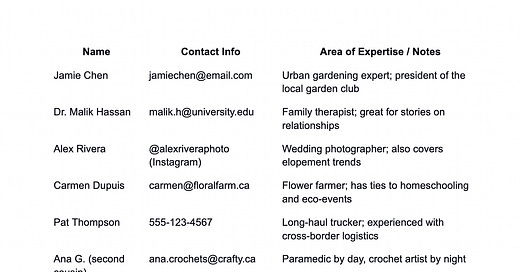The Freelance Writer’s Secret Weapon: A Source Tracking System
Plus: You're going to love these upcoming newsletters
Coming soon…
The next Pitching Power Hour co-working session is July 9th
My summer reading list is next week and…
Your mid-year business check list is the week after that!
If you’ve ever struggled to find the perfect person to quote in a story—someone who can add credibility, colour, and insight to your work—you’re not alone. Outside voices enhance even the most personal of essays and can help readers connect to your work. Plus, editors love to see thoughtful sourcing because it shows you’re not just serious about the story—you’re serious about getting it right. However, starting from scratch each time you get a new assignment takes time and energy.
That’s why one of the smartest things any freelance writer can do is to create a simple source-tracking document. This doesn’t have to be complicated or high-tech. An Excel spreadsheet, a Google Doc, even an old-fashioned notebook—anything will do.
Here’s what every source-tracking document needs:
Name
Contact info
Area of expertise or what they can speak to
That’s it. Three fields. But it can change everything.
Why? A source isn’t just a source. It’s a relationship. Sources are like story seeds. A fun story about pink food for a Barbie-themed trend piece might lead you to a beet farmer who also runs homeschooling co-ops and side hustles in the wedding industry. That one call could lead to three future stories. Plus, a good source can be a great connector. Once you’ve earned someone’s trust, they might be happy to introduce you to others in their field—or even share what trends they’re noticing. However, it’s easy enough to let these little things slip your mind. Are you really going to remember that the farmer has wedding industry experience in a year or two? Jotting this info down in your source document today will make your future stories that much easier - and richer.
Here’s what it looks like:
And when you maintain a simple source doc, it becomes easy to build long-term relationships with your sources. Having all those email addresses organized is helpful! At the end of each year, I send a short, cheerful e-card to thank everyone who was a source for me. It’s a small gesture, but it shows appreciation—and it keeps connections warm for the future.
When you’re mapping out new story ideas and pitching goals, don’t stop at a headline and a hook. Ask yourself: Who can help make this piece richer, deeper, and more compelling? Then write their name down. That’s all there is to it, and you’ll never regret having a source-tracking document by your side.
Happy weekend, everyone!
Vanessa
PS… A helpful reminder for anyone struggling to get words on paper this week.





